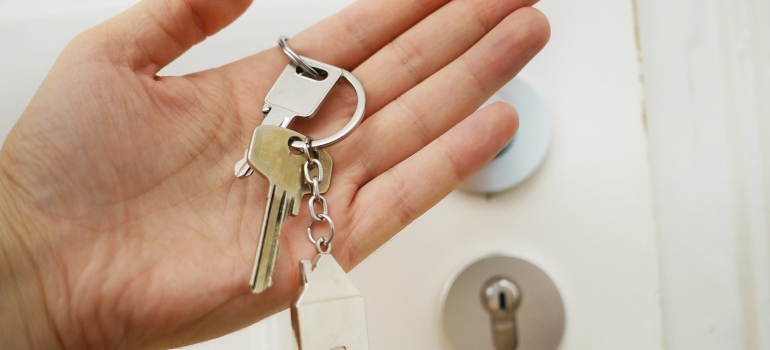Purchasing a house, particularly in Texas, is a milestone. Yet, it’s crucial to identify what questions to ask and red flags to look for at open houses in Texas. Expert advice from long distance moving companies emphasizes the importance of meticulous property inspections to prevent future issues. All house aspects, from structural integrity to neighborhood qualities, require careful examination. This guide will provide essential information to effectively evaluate Texas open houses. Armed with these insights, you’ll be better prepared to make informed decisions in your home-buying process.
A quick guide to Texas open houses: What to keep an eye on
Open houses in Texas present a unique opportunity to thoroughly inspect potential homes before making a purchasing decision. Having a checklist of things to look for can greatly streamline the process. Here are the key factors to pay attention to:
- The condition and age of the house’s structure, including the roof, foundation, and walls.
- Signs of water damage or plumbing problems.
- The state and age of the electrical system.
- The performance and maintenance history of the HVAC system.
- The quality of local schools, proximity to amenities, and the safety of the neighborhood.
- Disclosures and property history provided by the seller.
- Any recent renovations or additions to the property.
- The regularity of maintenance and upkeep on the property.
- The property’s susceptibility to natural disasters, such as flooding, hurricanes, or wildfires.
- The property’s ownership history and any outstanding liens or encumbrances.

Identifying Structural Issues: Key Tips for Open Houses in San Antonio
One major aspect to be aware of when considering a move to a city like San Antonio is the structure of potential homes. From experience, the long distance moving companies San Antonio offers would affirm the crucial nature of being informed about the structural soundness of a house.
Start by asking about the age of the roof. A well-maintained roof can last anywhere between 15 to 30 years, but this varies based on the materials used and weather conditions it’s been exposed to. Sagging or bowing, signs of water damage, or multiple layers of shingles could suggest a roof in need of repair or replacement. Next, probe into the foundation of the house. The foundation is the bedrock of a home, and its health is critical. Ask if there have been any signs of foundation problems like cracks in the walls, doors that don’t close properly, or floors that sag or bounce. If the house has a basement, look for any water seepage, as this could be a sign of foundation cracks. Finally, don’t forget the walls. They can tell a lot about a house’s structural health. Ask if there’s been any shifting or movement in the house, which could lead to cracks in the walls. Note if there are patches or spots of fresh paint, which could be attempts to hide such issues.
The role of water damage and plumbing at Austin open houses
Water damage and plumbing issues can indeed be a thorn in a homeowner’s side. Because of that, when engaging with long distance moving companies Austin TX, understanding the potential home’s plumbing history is paramount. Start by asking about any past water damage. Water damage can originate from various sources such as roof leaks, faulty gutters, or even severe weather conditions. Signs may not always be apparent, so ask if the home has experienced flooding or persistent leaks in the past. Visible water stains, mold, or discoloration on walls and ceilings are telltale signs of water damage.
Musty odors are another red flag. They often indicate the presence of mold or mildew, which thrive in damp conditions. Don’t dismiss these smells as “old house smell”. They could signal costly repairs in the future. Asking about the house’s plumbing history is also crucial. Old, corroded pipes or ones made from outdated materials can cause numerous issues down the line. Inquire about the age and type of the plumbing pipes and any recent repairs or replacements. Evidence of recent repairs can be double-edged. While it shows that the owners are proactive, it may also hint at ongoing issues. Fresh paint or newly replaced sections of walls or flooring in certain areas may signify attempts to fix water damage.

Key questions for open houses in Houston
While liaising with long distance movers Houston TX in anticipation of your move, gaining insights into the home’s electrical system is critical. Start by asking about the age of the electrical wiring and panel. Knowing this can inform you about the likelihood of encountering issues in the future. Modern electrical wiring can last several decades, but if the house is old and the wiring hasn’t been updated, it may be close to its lifespan’s end.
Next, look for signs of outdated electrical systems. Older homes may still have fuse boxes instead of circuit breakers. Fuse boxes aren’t inherently dangerous, but they’re obsolete, and upgrading to a circuit breaker can improve safety and convenience. Keep an eye out for exposed wiring as well. Not only does it present a risk of electrical shock, but it’s also a potential fire hazard. Any visible wires should be encased in a protective conduit. Flickering lights can be another telltale sign of potential electrical problems. It could mean several things – issues with the lightbulb, problems with the light fixture, or more worryingly, a fault in the electrical circuit. The capacity of the electrical panel is also worth checking. If the home has been renovated or expanded without upgrading the electrical panel, it may be overloaded, leading to frequent circuit breaker trips.
Examining HVAC systems in Dallas open houses
When coordinating your move with interstate movers Dallas, taking time to inspect the heating, ventilation, and air conditioning (HVAC) systems of potential homes is crucial. Start by asking about the system’s age. Most HVAC systems have a lifespan of 15-20 years, but their efficiency can decline over time. If the system is nearing or past this age, it may need replacing soon, which is a significant cost to consider. Next, ask about the maintenance history. Regular maintenance is key to an HVAC system’s longevity and efficiency. Look for a history of yearly check-ups and ask about any significant repairs or replacements. If the previous owners have neglected the HVAC system’s upkeep, it could be a costly oversight.
Additionally, ask about the system’s energy efficiency. Energy-efficient models not only reduce carbon footprint but can also save money on utility bills. Check if the system has an Energy Star label, which indicates it meets the U.S. Environmental Protection Agency’s efficiency standards. Observe how the system operates during your visit. Pay attention to the airflow from the vents – it should be strong, not weak or inconsistent. Unusual noises like banging, whistling, or rattling can suggest mechanical issues, while an inconsistent temperature between rooms may indicate problems with ductwork.

Evaluating neighborhood factors in Texas
Working with long distance moving companies Texas, you will quickly realize that the neighborhood plays a significant role in your overall satisfaction with your new home. One of the crucial aspects to consider is the quality of nearby schools. Even if you don’t have children, the quality of schools can impact property values. Research the schools’ ratings online or ask local residents about their experiences. The proximity to amenities is another key factor. Consider your lifestyle and what amenities you use most often. If you enjoy dining out, check out the local restaurant scene. If outdoor activities are your preference, look for nearby parks or recreation centers. Commuting to work? Consider the proximity to public transportation or major highways.
Safety should be a primary concern. Check crime rates in the neighborhood online and talk to potential neighbors about their experiences. Remember, a safe neighborhood contributes significantly to your quality of life. Pay attention to the neighborhood’s vibe during your visit. Is there heavy traffic on the local roads? Do you hear excessive noise, such as from busy roads or commercial activities? If you value peace and quiet, these could be significant detractors. Inspect the conditions of neighboring properties too. Well-maintained properties can indicate a sense of community pride, while unkempt properties could signify problems.

Checking disclosure and property history
While preparing for your move and considering hiring long distance movers, make sure to pay extra attention to the disclosure and history of your potential new home.
- Property disclosures provide valuable information about a house’s condition. They reveal any past repairs, renovations, or legal issues the property might have had. This information is crucial for understanding the house’s integrity. For instance, if there were past repairs for foundational issues, you might need to plan for potential future repairs.
- Legal issues such as disputes over property lines or previous owners’ unpaid debts can affect your ownership and enjoyment of the property. Make sure to consult with a real estate attorney if any such issues arise during your review of the disclosures.
- Renovations can improve a home’s aesthetics and functionality, but ensure these upgrades were done with proper permits. Unpermitted renovations can lead to future legal complications and might even require you to undo the changes.
- An important red flag to watch out for is inconsistencies or vague responses in the provided information. If the seller is unable to provide clear answers about previous repairs or legal issues, it could be a sign they are trying to hide something.
Scrutinizing a property’s disclosure and history might seem tedious, but it’s a critical step in the home-buying process. It will help you to avoid unexpected surprises and make a more informed decision about your potential new home.
Inspecting renovations and additions
On your long distance moving checklist, include inspecting any renovations or additions made to the prospective property. The quality of these enhancements can have a significant impact on the home’s value and your future living experience.
- Assess the quality of craftsmanship. Are the renovations professionally done, or do they seem hastily put together? For example, in the kitchen, are the cabinets properly aligned and secured? Are the countertops level, and does the plumbing under the sink appear professionally installed? Poor workmanship could lead to costly repairs down the road.
- Ensure that all renovations and additions were permitted. Unpermitted work, such as building an additional room without a permit, could result in fines or legal troubles. Ask the homeowner for proof of permits for any significant renovations.
- Consider how these enhancements could affect the property’s value. A well-executed, modern kitchen renovation can significantly increase a home’s value, while a poorly done renovation can do the opposite.

Assessing maintenance and upkeep
One key factor to consider during your house hunting is the level of maintenance and upkeep of the property. A well-maintained house often means fewer surprises in terms of repairs and renovations after you move in. Start your inspection from the outside. Is the landscaping well-kept, or are there signs of neglect like overgrown grass, bushes, and trees? Landscaping is not only an aesthetic concern, but poor maintenance can also cause damage to the property over time. For instance, trees with overgrown roots can impact the house’s foundation, leading to costly repairs.
Next, observe the house’s paintwork. Peeling or faded paint might seem like a minor issue, but it could be a sign of more significant problems, such as water infiltration or deteriorating materials underneath. Look at the state of the windows and doors. Are they in good condition, or do they show signs of weathering or rot? Remember, replacing windows and doors can be a significant expense. The state of the roof is another critical area to consider. Look for missing shingles or other visible signs of wear. If possible, ask about the age of the roof and when it was last replaced.
Understanding natural disaster risks
While the state of Texas offers a rich cultural experience and diverse living options, it’s also subject to specific natural disasters like hurricanes and floods. Therefore, understanding the property’s potential exposure to these risks is crucial.
Start by asking about the property’s location relative to designated flood zones. The Federal Emergency Management Agency (FEMA) provides flood zone maps that you can cross-reference. Being in a flood zone could mean higher insurance premiums and potential flood damage risks. Look out for signs of previous water damage in the house. This could be in the form of water stains, warped floors, or a strong musty smell. While some water damage can be fixed, repeated flooding can lead to long-term issues like structural instability and mold growth. Also, inquire about disaster mitigation measures already in place. This could include elevated construction, flood barriers, or hurricane-resistant features like impact-resistant windows or reinforced roofs. These features can significantly reduce potential damage and could save you money and stress in the long run.
Financing and ownership details
Understanding the property’s ownership history and financial liabilities is an essential part of your open house checklist. The ownership history can reveal useful information about the property’s maintenance and potential problems. For instance, frequent changes in ownership might indicate issues with the house or the neighborhood.
Additionally, pay attention to any outstanding liens or encumbrances on the property. A lien is a legal claim made on a property to secure the payment of a debt. This could relate to unpaid property taxes, contractor’s fees, or Homeowners Association (HOA) dues. Purchasing a property with a lien can lead to financial obligations that you might be unaware of. Similarly, check for unresolved disputes related to the property. This could include boundary disputes with neighbors or unresolved zoning issues. These types of disputes can lead to legal complications and additional costs in the future.

Key questions to ask and red flags to look for at open houses in Texas
When it comes to buying a house, being equipped with the right questions to ask and red flags to look for at open houses in Texas is crucial. As you journey from one property to another, don’t forget to consider these crucial factors to ensure you make a sound and informed investment. Trust your instincts, and don’t be afraid to ask questions. After all, your new home isn’t just a financial investment; it’s a space to build your future.
